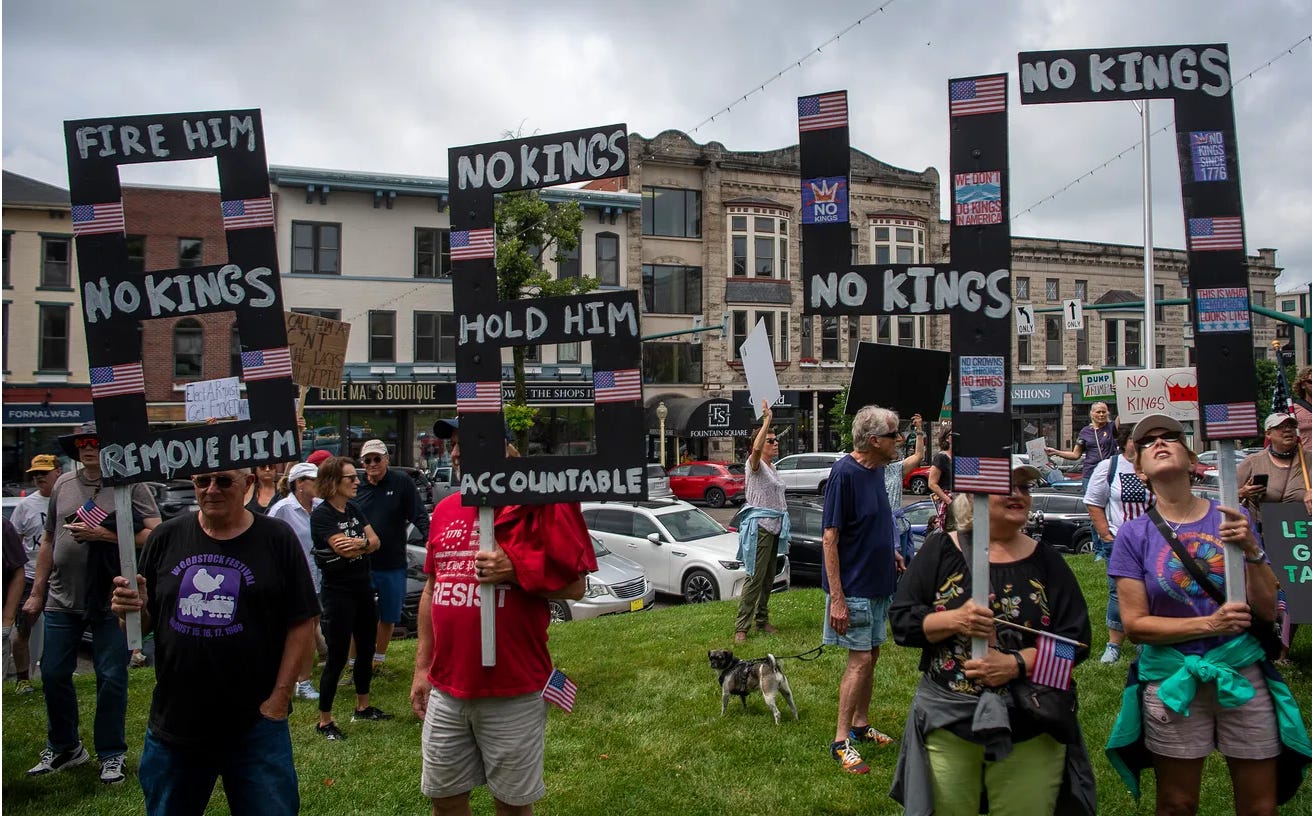I blundered into a demonstration yesterday.
Or rather I was in Bloomington for other errands, and was having lunch when a dear friend of mine texted me to say that she was nervous and excited for the day. For what? I had to ask. My signal chats were mostly silent, my mind was mostly occupied with other more urgent matters, and I had read something brief online about the No Kings movement being supported by a WalMart heir. In any case, heavy with the lunch I had just consumed, I went back to my car and immediately regretted that I left my keffiyeh back home. I decided instead to remove the Palestine flag sticker from my water bottle and affix it directly to the bill of my hat. I walked to the public square.
(yeah I was here yesterday. photos: Rich Janzaruk, Bloomington Herald-Times)
My immediate thought was “wow there are a lot of American flags here.” Of course it was flag day, but I wonder how effective capturing and occupying that space (of what we might call “critical nationalism,” or “engaged patriotism”) really is at this point. After years of support for genocide, and an immersion in settler-colonial studies, the US flag to me stands as a provocation. Clearly, from the size of the crowd (large), and the response from passers-by (mostly supportive, positive), others don’t see things this way. The unresolved tension here — the need to engage and critique, but only in a limited, contingent, anti-Trump way — I think is a problem. Who could realistically look at the US right now and blame everything on Trump? This seems a rather low-information way to look at things.
Put differently, there are really two protest movements. Some of this will sound reductionistic, and it *is* based on the semiotics of protest signs and speeches, so at risk of sounding like Benjamin Barber (RIP), here are some initial observations.
Pink Hats versus Keffiyehs
The first movement is tied institutionally to the Democratic party: it cares about Ukraine (I saw some yellow and blue flags), continues to inherit mostly unproblematically the narrative of Russian interference in the first Trump election, continues to revere Obama and Harris. And yet note this: I did not see *any* signs referring to Biden or Blinken. Already this interregnum is being memory-holed. There was definitely a time-is-a-flat-circle kind of feeling: the signs and slogans felt mostly warmed-over, a relic of 2016. Again, who could look at the current political scene and say “this is fine, but orange man is bad”? This is a politics of stasis when the world around us is moving faster than ever.
The second movement is, alas, much smaller. It is much younger. Its sign or cipher is the Palestinian flag, the keffiyeh. It calls out Zionists, rightly. Its anger is much more out-front and palpable, and yet for precisely this reason its message is clearer and more representative of the political world in its holistic complexity. Speeches address settler-colonialism, racism, academic freedom/cops on campus, and of course globalizing the student intifada: its active modes are not only occasional protests but also campus encampments/occupations.
These are movements in tension. They have different goals, different leaders, different visions of the future: one has an institutional basis (although one with very weak leaders and no real oppositional force), while the other has no real power or representation except perhaps in a few US cities. A clear generational divide exists. And while I never felt threatened or antagonized at the No Kings demonstration, the disparity or difference at a semiotic-cognitive level was a bit jarring. I was a fish out of water. At the same time, I saw a couple of well-known activists there, and they were clearly working on coalition-building, There *is* in fact a thread that can connect us, which is the program of abolishing ICE. Even the die-hard brunch set is pissed about this issue. Although some Democrats continue to think “being tough on immigration” is a winning strategy, Trump is attempting to mobilize an essentially private police force. If this continues to happen, and if the US military is also brought into the picture, new conjunctural opportunities will arise. Liberals will become radicalized; the pink hats might be replaced by keffiyehs, or maybe some combination of both can become possible. It’s wrong and in fact a little laughable to focus on Trump’s parade, which of course was a dud. But the effort to capture and mobilize a private military: this is in fact worth resisting and it can form the basis for a coalition.





